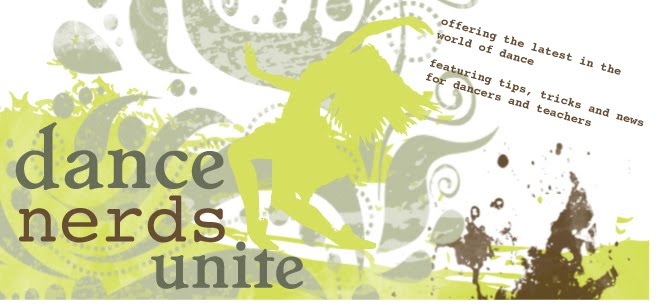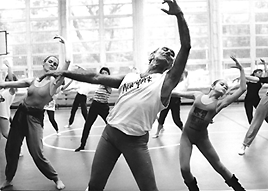- Jazz is indigenous to America, and began with the African slaves, who secretly danced to cling to their traditions and culture, but were not allowed to by the Slave Act of 1740.
- The Africans brought their rhythms to America - earthy; low, knees bent, pulsating body movements emphasized by body isolations and hand-clapping.
- By the 1920s, as the jazz movement was sweeping from New Orleans to the rest of the country, jazz and tap dance gained popularity. The two dance forms were often the same - with tap being referred to jazz.
- Until the mid 1950s, the term "jazz dance" often referred to tap dance, because tap dancing (set to jazz music) was the main performance dance of the era. During the later jazz age, popular forms of jazz dance were the Cakewalk, Black Bottom, Charleston, Jitterbug, Boogie Woogie, Swing dancing and the related Lindy Hop. (dancelessons.net)
- With World War II came a stop to the popularity of jazz social dancing, and jazz dance as a professional dance, performed by dancers who were trained in ballet and modern, came to life.
- During this time (the 1940s), Jack Cole, known as the "Father of Jazz Dance," began working in Hollywood training actors and actresses in jazz dance for movies.
- Jack Cole is credited with developing the ballet-based movements and theatrical expression which are the touchstones of contemporary jazz dancing. (Dance Tutors)
- Cole's style was seen in his musicals such as "A Funny Thing Happened on the Way to the Forum," "There's No Business Like Show Business," and "Man of La Mancha." It was also seen in his movies, including, "Gentlemen Prefer Blondes" and "There’s No Business Like Show Business."
- By the 1950s, Jerome Robbins, who was greatly influenced by Cole, became famous for his jazz choreography with the Broadway production of "West Side Story."
- In the 1960s, jazz greats Luigi and Gus Giordano gained fame - Luigi's for his holistic, lyrical jazz style that helped him recover from a serious auto accident.
- Giordano's style was known for isolation movements, emphasizing the head and torso and creating an uplifted look of elegance. Yoga is incorporated into Giordano’s technique as a means of relaxation. (University of Houston - Jacqueline Nallet).
- Later, in the 1970s, Bob Fosse appeared on the scene dancing and choreographing Broadway plays such as "Dancin" and a reproduction of "Chicago."
- Fosse's style was distinct; it was highly creative and often included bizarre movements; it was slick, erotic and intense. He was a one man jazz phenomenon whose style continued to make its mark on the Broadway stage and in Hollywood throughout the 1980s. (University of Houston - Jacqueline Nallet)
Saturday, September 18, 2010
Some Jazz Dance History
Most of us probably think history is pretty boring, like learning dates and wars and names. But, as discussed in the previous blog, true jazz dance is dying in part due to the fact that we don't know it's history and origins. So, I've pulled the must-know jazz history facts, to make it a little less boring, but also to make sure we all know more about this incredible dance form!
Labels:
Bob Fosse,
Gus Giordano,
Jack Cole,
Jazz,
Jazz History,
Jerome Robbins,
Luigi
Thursday, September 16, 2010
Keeping Jazz Dance Alive
The jazz legend, Gus Giordano, dancing with his wife
There was an excellent article in Dance Teacher Magazine this month - Carrying the Jazz Dance Torch. It discusses how teachers are no longer teaching jazz dance history and the correct roots of it. Instead, we are focusing on what's sexy, tricks, and throwing in elements of contemporary and hip-hop so that jazz is hardly recognizable. I have really found this to be true in the last few years at competitions. My students performed a classic jazz-style piece to a Prince classic and it garnered positive responses from the judges for being a traditional jazz dance. Watch "So You Think You Can Dance" and you'll see those judges responding well to real jazz dances as well. There has been a trend for many years leading us away from jazz, but I think the pendulum is starting to swing the other way.
Here are some highlights I pulled from the article:
- "So You Think You Can Dance" judges and produces often describe dances as jazz "when they often have very little jazz quality and are technically more contemporary or hip hop."
- "Experts say the misinterpretation of jazz dance, along with teachers who focus on contemporary styles and a general lack of knowledge about the artform, is helping to contribute to the loss of jazz dance’s historical and cultural lineage."
- "A full understanding of jazz dance can help dancers to better embody the work of any choreographer or culture."
- “Many times people think jazz dance just needs to be sexy and face the audience and have a lot of tricks. People need to step away from that and realize that this is an artform that has a rich cultural history, especially for our country.”
- "Jazz dance grew out of African music and dance roots, including jazz music. It is based on stylistic vernacular movements (social dances created outside of a studio), but during the 1950s, a split from vernacular-based jazz dance (cakewalk, Charleston, jitterbug, swing, etc.) created a theatrical-based version of jazz dance with Caribbean and Latin American influences."
- "Jazz dance should not be learned in order to please an audience."
- "To be included in the jazz dance heritage a dance work should embody a noticeable amount of traditional jazz dance movement characteristics. That would include dancing in plié, movement that emanates from the pelvis and through the extremities, isolations, syncopation, dynamic extremes, strong energy flow either in visible bursts or in contained format (hot vs. cool), and letting the movement reflect reactions to rhythmic accompaniment."
- "To focus exclusively on the contemporary style, which tends to be a mix of ballet and modern with few jazz qualities, “without mastering the deep well of potential and power than can be found in the vernacular is a wasted opportunity to expand and improve one’s expressive skills." "
- "Make sure to utilize the core elements of traditional jazz dance—an earthy quality, pliés, isolations and syncopation."
- "A lot of jazz dance is done to popular music with a strong beat, putting the movements on the one-count, and that is not what characterizes jazz."
Labels:
Bob Fosse,
Dance Magazine,
Gus Giordano,
Jazz
Subscribe to:
Posts (Atom)





